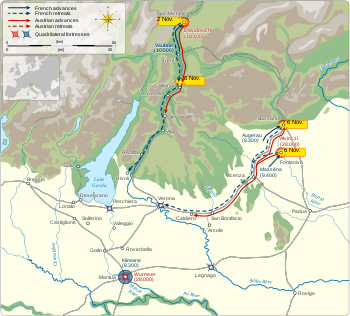Battle of Caldiero (1796)
| Battle of Caldiero, 1796 | |||||||
|---|---|---|---|---|---|---|---|
| Part of French Revolutionary Wars | |||||||
| |||||||
| Belligerents | |||||||
|
First French Republic |
| ||||||
| Commanders and leaders | |||||||
| Strength | |||||||
| 13,000 infantry | 18,000 infantry | ||||||
| Casualties and losses | |||||||
| 1,800 dead and wounded, 2 guns | 1,300 dead and wounded | ||||||
In the Battle of Caldiero on 12 November 1796, the
The battle was part of the third Austrian effort to relieve the
Background
On 2 November 1796,
To face the twin threats, Bonaparte deployed a 10,500-man division led by
On 6 November, Bonaparte with 19,500 men, including Massena, Augereau, and a reserve brigade, attacked Alvinczi at Bassano and Fontaniva. In the hard-fought Second Battle of Bassano, Alvinczi and his two division commanders, Feldmarschall-Leutnants Peter Vitus von Quosdanovich and Giovanni Marchese di Provera, repelled their outnumbered opponents. French losses were 3,000 killed, wounded, and captured, while Alvinczi's army suffered about 2,800 casualties.[3]
Davidovich routed Vaubois in the Battle of Calliano on 7 November, inflicting 4,400 casualties on the French for an Austrian loss of 3,500.[4] Bonaparte focused on the threat from the north as he pulled back his eastern force to Verona. Davidovich remained inactive because he was under the mistaken impression that Masséna's division had reinforced Vaubois.
Battle
By 11 November, Alvinczi's advance elements reached
Bonaparte sent a total of 13,000 men to attack Hohenzollern's position.[5] Masséna drove against the Austrian right and Augereau attacked the Austrian left, The Austrians, who had fortified themselves in several villages, sturdily resisted the French assaults. A violent rain and hail storm blew in the faces of the French troops, making it difficult for them to prime their muskets. At mid-day, Masséna began making headway on the Austrian right. In the afternoon, the brigades of Generals-major Adolf Brabeck and Anton Schübirz von Chobinin arrived on the field. Soon the Austrians forced back Masséna. Provera also appeared and drove back Augereau. The arrival of nightfall allowed the French to pull safely back into Verona.[6]
Result

The French suffered 1,000 killed and wounded, plus 800 men and two artillery pieces captured. The Austrians lost 950 killed and wounded, and 350 captured.
Notes
References
- Boycott-Brown, Martin (2001). The Road to Rivoli: Napoleon's First Campaign. London: Cassell & Co. ISBN 0-304-35305-1.
- Chandler, David G. (1966). The Campaigns of Napoleon. New York: Macmillan.
- Fiebeger, G. J. (1911). The Campaigns of Napoleon Bonaparte of 1796–1797. West Point, New York: US Military Academy Printing Office.
- ISBN 1-85367-276-9.


